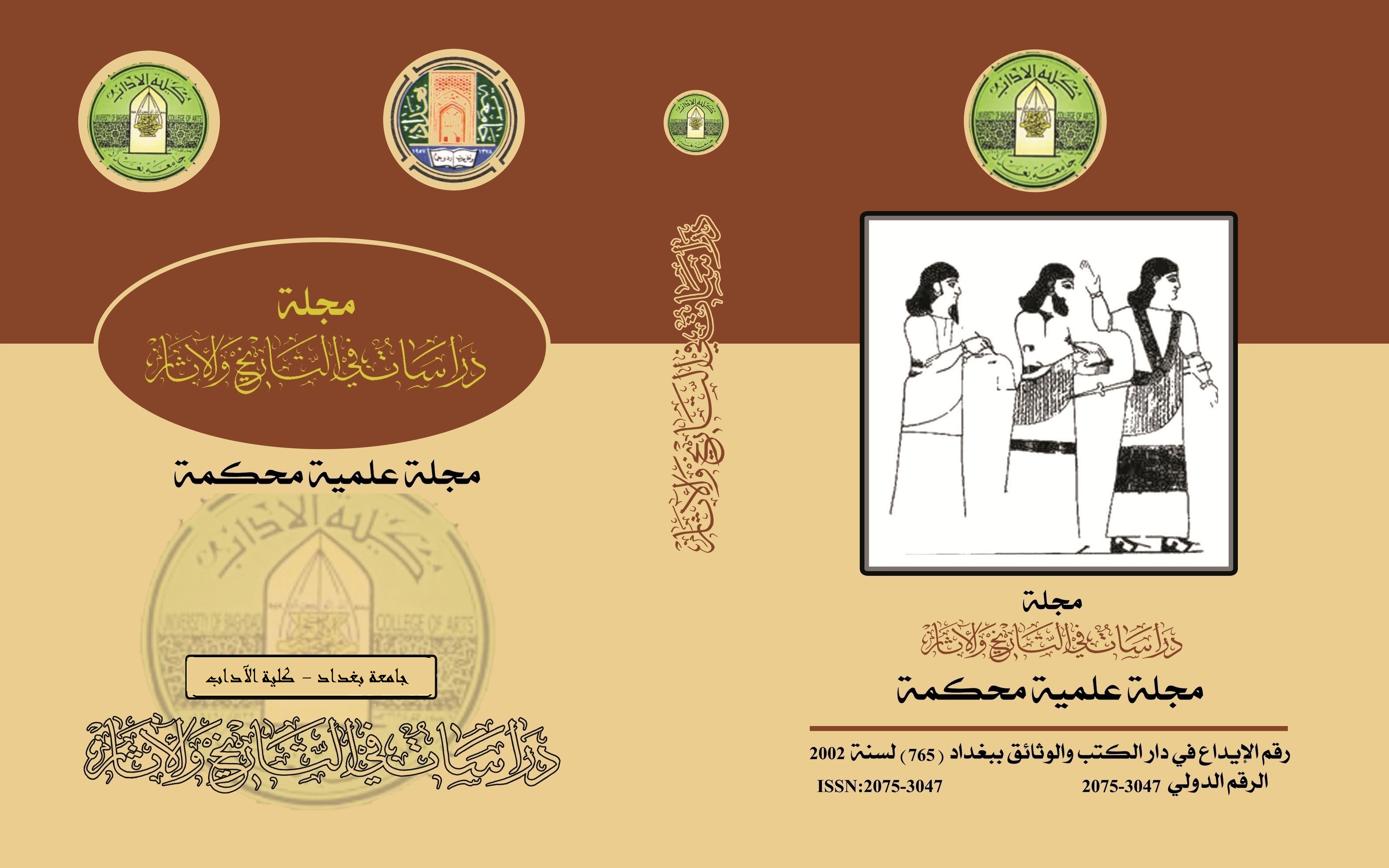المجتمع العراقي برؤية يابانية: دراسة سوسيولوجية
الكلمات المفتاحية:
المجتمع العراقي، المجتمع الياباني، الصورة النمطيةالملخص
تستعرض الدراسة الموسومة " المجتمع العراقي برؤية يابانية: دراسة سوسيولوجية" رؤية بعض افراد المجتمع الياباني عن المجتمع العراقي ويركز موضوع الدراسة على الصورة النمطية عن الاخر والأخرين وتنتج هذه الصورة سلوك وتجاوب محدد بناء على ما تم تغذيته في اللاشعور وتحاول هذه الدراسة معرفة الصورة النمطية عن العراقيين بعيون يابانية ، فرغم المسافة الجغرافية بين البلدين والتفاوت التكنلوجي والاقتصادي الا ان اليابان والعراق يرتبطان بعلاقات تاريخية بالجانب السياسي والاقتصادي تفاوتت حسب الوضع السياسي والأمني والاقتصادي وهدفت الدراسة الى تحليل رؤية الاكاديميين اليابانيين من خلال استخدام تحليل الوثائق لمجموعة من المقالات والبحوث ، كذلك تم استخدام أداة المقابلة وتم تطبيقها على (24) مبحوث من اليابان ، وركز الدراسة على السؤال كيف يرى اليابان المجتمع العراقي ؟ وتوصلت الدراسة الى مجموعة نتائج منها انحصار بعض البحوث الاكاديمية على جانب محدد بسبب البعد التاريخي والزماني لكتابة البحث وكذلك بسبب شخصية الباحث ومنصبه الذي يملي عليه الكتابة في موضوع محدد ، في حين توصلت نتائج المقابلات الى ان الأساتذة والطلاب لديهم المام وصورة إيجابية عن المجتمع العراقي ولكنهم يترددون في نشر وتعميم هذا المحتوى بسبب الأوضاع الأمنية في وقتها ، اما عامة الناس في اليابان فكانوا بين الذين ليس لديهم أي تصور عن المجتمع العراقي وبين الذين لديهم تصور سلبي عن المجتمع العراقي بسبب الصورة النمطية للمجتمع
المراجع
• ابن منظور. (2003). لسان العرب. دار الحديث، القاهرة.
• بعلبكي، أ. (2009). تنمية المجتمع المحلي والتدريب على بناء قدراته، ج1. دراسات عراقية، بيروت.
• الجبوري، إ. ز. (1973). الصورة النمطية: صورة العرب في مجلة التايم، رسالة ماجستير غير منشورة، جامعة بغداد، كلية الآداب، قسم الإعلام، ص 16-17.
• جوهر، ع. (2002). أبيك - قليل من الاقتصاد وكثير من الإرهاب. مجلة السياسة الدولية، العدد 147، ص 146.
• الجوهري، م.، و الخريجي، ع. (2001). طرق البحث الاجتماعي. مطبعة العمرانية، مصر.
• جيدير، م. (2004). منهجية البحث (ترجمة ملكة أبيض). منشورات وزارة الثقافة السورية، سوريا.
• الحسن، إ. م.، و الحسني، ع. م. (1981). طرق البحث الاجتماعي. دار الكتب للطباعة والنشر، الموصل.
• خضور، أ. (2002). صورة العرب في الإعلام الغربي. المكتبة الإعلامية، دمشق.
• ساكاي، ك.، و القيسي، م. ع. (2009). العراق واليابان: تاريخ وعلاقات (ترجمة وتقديم: علي حسون ومحمود عبد الواحد). بغداد.
• شكر، ن. ن. (2009). الوجود الياباني في العراق. مجلة دراسات دولية، مركز الدراسات الاستراتيجية والدولية، العدد 40، ص 96.
• الشيخ، ص. (2009). تكوين الصورة الذهنية للشركات ودور العلاقات العامة فيها، بحث مقدم لنيل درجة الدبلوم في العلاقات العامة، الأكاديمية السورية الدولية، ص 4-5.
• عوديشو، و. أ. (2008). النظام السياسي والسياسة الخارجية اليابانية المعاصرة، رسالة ماجستير غير منشورة، الأكاديمية العربية المفتوحة في الدنمارك، كلية القانون والسياسة، ص 101.
• الغرايبة، ف. وآخرون. (2002). أساليب البحث العلمي في العلوم الإنسانية والاجتماعية. دار وائل للنشر والتوزيع، عمان – الأردن.
• القصير، م. ع.، و العمر، م. خ. (1981). المدخل إلى علم الاجتماع. مطابع جامعة بغداد.
• كشرود، ع. ط. (2007). البحث العلمي ومناهجه. دار المناهج للنشر والتوزيع، الأردن.
• مورو، ف. (2003). البلاغة: مدخل لدراسة الصور البيانية (ترجمة: محمد الولي وعائشة جرير). إفريقيا الشرق، الدار البيضاء.
المصادر الاجنبية
• . Bowen, G. A. (2009). Document Analysis as a Qualitative Research Method. Qualitative Research Journal, 9(2), 27-40.
• Boulding, E. (1956). The Image. University of Michigan Press.
• Iverft, H. (1996). Japan’s Links with East and Southeast Asia. Aussen Politic, 47(1), 73.
• Lee, S. C. (1979). The American Image of Relations with Japan Projected in Three U.S. Dailies. Gazette, 25, 31.
• Miyagi, Y. (2009). Foreign Policy Making Under Koizumi: Norms and Japan's Role in the 2003 Iraq War. Foreign Policy Analysis, 5(4), 349–366. https://doi.org/10.1111/j.1743-8594.2009.00097.x
- تاريخ الاطلاع: 28 أكتوبر 2024
التنزيلات
منشور
إصدار
القسم
الرخصة

هذا العمل مرخص بموجب Creative Commons Attribution 4.0 International License.
:حقوق الطبع والنشر والترخيص
بالنسبة لجميع البحوث المنشورة في مجلة دراسات في التاريخ والآثار، يحتفظ الباحثون بحقوق النشر. يتم ترخيص البحوث بموجب ترخيص Creative Commons CC BY 4.0 المفتوح ، مما يعني أنه يجوز لأي شخص تنزيل البحث وقراءته مجانًا. بالإضافة إلى ذلك ، يجوز إعادة استخدام البحث واقتباسه شريطة أن يتم الاستشهاد المصدر المنشور الأصلي. تتيح هذه الشروط الاستخدام الأقصى لعمل الباحث وعرضه.
:إعادة إنتاج البحوث المنشورة من الناشرين الآخرين
من الضروري للغاية أن يحصل الباحثون على إذن لإعادة إنتاج أي بحث منشورة (أشكال أو مخططات أو جداول أو أي مقتطفات من نص) لا يدخل في نطاق الملكية العامة أو لا يملكون حقوق نشرها. يجب أن يطلب الباحثون إذنًا من مؤلف حقوق النشر (عادة ما يكون الناشر).
يطلب الإذن في الحالات التالية:
بحوثك الخاصة المنشورة من قِبل ناشرين آخرين ولم تحتفظ بحقوق النشر الخاصة بها.
مقتطفات كبيرة من بحوث أي شخص أو سلسلة من البحوث المنشورة.
استخدم الجداول والرسوم البيانية والمخططات والمخططات والأعمال الفنية إذا لم يتم التعديل عليها.
الصور الفوتوغرافية التي لا تملك حقوق لنشرها.
لا يطلب الإذن في الحالات التالية:
إعادة بناء الجدول الخاص بك مع البيانات المنشورة بالفعل في مكان آخر. يرجى ملاحظة أنه في هذه الحالة يجب عليك ذكر مصدر البيانات في شكل "بيانات من ..." أو "مقتبس من ...".
تعتبر عروض الأسعار القصيرة معقولة الاستخدام العادل ، وبالتالي لا تتطلب إذنًا.
الرسوم البيانية ، الرسوم البيانية ، المخططات ، الأعمال الفنية التي أعاد الباحث رسمها بالكامل والتي تم تغييرها بشكل ملحوظ إلى درجة لا تتطلب الاعتراف.
الحصول على إذن
لتجنب التأخير غير الضروري في عملية النشر ، يجب أن تبدأ في الحصول على أذونات في أقرب وقت ممكن. لا يمكن لمجلة الآداب نشر بحث مقتبس من منشورات أخرى دون إذن.
قد يمنحك مالك حقوق الطبع والنشر تعليمات بشأن شكل الإقرار الواجب اتباعه لتوثيق عمله ؛ بخلاف ذلك ، اتبع النمط: "مستنسخ بإذن من [المؤلف] ، [كتاب / المجلة] ؛ نشره [الناشر] ، [السنة]." في نهاية شرح الجدول ، الشكل أو المخطط.


















